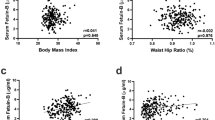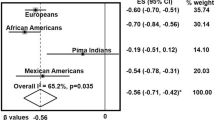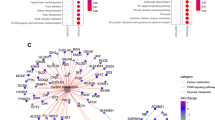Abstract
Objective:
Adiponectin signalling attenuates insulin resistance (IR) and steatosis hepatis in animal models. As adiponectin receptor (ADIPOR)1 and ADIPOR2 are critical components in the adiponectin signalling cascade, we studied hepatic ADIPOR1/2 mRNA levels in humans and their relation to IR.
Design:
We determined metabolic risk factors and levels of hepatic mRNA transcribed from ADIPOR1, ADIPOR2 and FOXO1, a putative up-stream regulator, in 43 and 34 obese subjects with low and high homeostasis model assessment-IR, respectively.
Results:
Plasma adiponectin and metabolic risk factors showed associations with IR as expected. Both hepatic ADIPOR1 and ADIPOR2 mRNA expression levels were higher in insulin-resistant subjects (P<0.0035). ADIPOR1 mRNA correlated with FOXO1 mRNA in obese insulin resistant (P=0.0034), but not insulin-sensitive subjects, while no correlations of ADIPOR2 with FOXO1 mRNA were noted. FOXO1 enhanced transcription from the ADIPOR1, but not the ADIPOR2 promoter in HepG2 cells.
Conclusion:
Increased hepatic ADIPOR1 and ADIPOR2 mRNA in insulin-resistant obese subjects may, at least in part, reflect a compensatory mechanism for reduced plasma adiponectin. FOXO1 may contribute to enhanced ADIPOR1, but not ADIPOR2 transcription in IR.
This is a preview of subscription content, access via your institution
Access options
Subscribe to this journal
Receive 12 print issues and online access
$259.00 per year
only $21.58 per issue
Buy this article
- Purchase on Springer Link
- Instant access to full article PDF
Prices may be subject to local taxes which are calculated during checkout

Similar content being viewed by others
Accession codes
References
Grundy SM . Metabolic syndrome: connecting and reconciling cardiovascular and diabetes worlds. J Am Coll Cardiol 2006; 47: 1093–1100.
Saltiel AR, Kahn CR . Insulin signalling and the regulation of glucose and lipid metabolism. Nature 2001; 414: 799–806.
Greenfield V, Cheung O, Sanyal AJ . Recent advances in nonalcholic fatty liver disease. Curr Opin Gastroenterol 2008; 24: 320–327.
Gavrilova O, Marcus-Samuels B, Graham D, Kim JK, Shulman GI, Castle AL et al. Surgical implantation of adipose tissue reverses diabetes in lipoatrophic mice. J Clin Invest 2000; 105: 271–278.
Simha V, Garg A . Lipodystrophy: lessons in lipid and energy metabolism. Curr Opin Lipidol 2006; 17: 162–169.
Shimomura I, Hammer RE, Richardson JA, Ikemoto S, Bashmakov Y, Goldstein JL et al. Insulin resistance and diabetes mellitus in transgenic mice expressing nuclear SREBP-1c in adipose tissue: model for congenital generalized lipodystrophy. Genes Dev 1998; 12: 3182–3194.
Shoelson SE, Lee J, Goldfine AB . Inflammation and insulin resistance. J Clin Invest 2006; 116: 1793–1801.
Rosen ED, Spiegelman BM . Adipocytes as regulators of energy balance and glucose homeostasis. Nature 2006; 444: 847–853.
Hotamisligil GS, Erbay E . Nutrient sensing and inflammation in metabolic diseases. Nat Rev Immunol 2008; 8: 923–934.
Wildman RP, Muntner P, Reynolds K, McGinn AP, Rajpathak S, Wylie-Rosett J et al. The obese without cardiometabolic risk factor clustering and the normal weight with cardiometabolic risk factor clustering: prevalence and correlates of 2 phenotypes among the US population (NHANES 1999-2004). Arch Intern Med 2008; 168: 1617–1624.
Aguilar-Salinas CA, Garcia EG, Robles L, Riano D, Ruiz-Gomez DG, Garcia-Ulloa AC et al. High adiponectin concentrations are associated with the metabolically healthy obese phenotype. J Clin Endocrinol Metab 2008; 93: 4075–4079.
Kadowaki T, Yamauchi T, Kubota N, Hara K, Ueki K, Tobe K . Adiponectin and adiponectin receptors in insulin resistance, diabetes, and the metabolic syndrome. J Clin Invest 2006; 116: 1784–1792.
Matsuzawa Y, Funahashi T, Kihara S, Shimomura I . Adiponectin and metabolic syndrome. Arterioscler Thromb Vasc Biol 2004; 24: 29–33.
Waki H, Yamauchi T, Kamon J, Ito Y, Uchida S, Kita S et al. Impaired multimerization of human adiponectin mutants associated with diabetes. Molecular structure and multimer formation of adiponectin. J Biol Chem 2003; 278: 40352–40363.
Pajvani UB, Du X, Combs TP, Berg AH, Rajala MW, Schulthess T et al. Structure-function studies of the adipocyte-secreted hormone Acrp30/adiponectin. Implications fpr metabolic regulation and bioactivity. J Biol Chem 2003; 278: 9073–9085.
Yamauchi T, Kamon J, Ito Y, Tsuchida A, Yokomizo T, Kita S et al. Cloning of adiponectin receptors that mediate antidiabetic metabolic effects. Nature 2003; 423: 762–769.
Yamauchi T, Nio Y, Maki T, Kobayashi M, Takazawa T, Iwabu M et al. Targeted disruption of AdipoR1 and AdipoR2 causes abrogation of adiponectin binding and metabolic actions. Nat Med 2007; 13: 332–339.
Berg AH, Combs TP, Du X, Brownlee M, Scherer PE . The adipocyte-secreted protein Acrp30 enhances hepatic insulin action. Nat Med 2001; 7: 947–953.
Yamauchi T, Kamon J, Minokoshi Y, Ito Y, Waki H, Uchida S et al. Adiponectin stimulates glucose utilization and fatty-acid oxidation by activating AMP-activated protein kinase. Nat Med 2002; 8: 1288–1295.
Tsuchida A, Yamauchi T, Ito Y, Hada Y, Maki T, Takekawa S et al. Insulin/Foxo1 pathway regulates expression levels of adiponectin receptors and adiponectin sensitivity. J Biol Chem 2004; 279: 30817–30822.
Pontiroli AE, Pizzocri P, Giacomelli M, Marchi M, Vedani P, Cucchi E et al. Ultrasound measurement of visceral and subcutaneous fat in morbidly obese patients before and after laparoscopic adjustable gastric banding: comparison with computerized tomography and with anthropometric measurements. Obes Surg 2002; 12: 648–651.
Luef GJ, Waldmann M, Sturm W, Naser A, Trinka E, Unterberger I et al. Valproate therapy and nonalcoholic fatty liver disease. Ann Neurol 2004; 55: 729–732.
Oberkofler H, Linnemayr V, Weitgasser R, Klein K, Xie M, Iglseder B et al. Complex haplotypes of the PGC-1alpha gene are associated with carbohydrate metabolism and type 2 diabetes. Diabetes 2004; 53: 1385–1393.
Esterbauer H, Schneitler C, Oberkofler H, Ebenbichler C, Paulweber B, Sandhofer F et al. A common polymorphism in the promoter of UCP2 is associated with decreased risk of obesity in middle-aged humans. Nat Genet 2001; 28: 178–183.
Hahne P, Krempler F, Schaap FG, Soyal SM, Hoffinger H, Miller K et al. Determinants of plasma apolipoprotein A-V and APOA5 gene transcripts in humans. J Intern Med 2008; 264: 452–462.
Oberkofler H, Esterbauer H, Linnemayr V, Strosberg AD, Krempler F, Patsch W . Peroxisome proliferator-activated receptor (PPAR) gamma coactivator-1 recruitment regulates PPAR subtype specificity. J Biol Chem 2002; 277: 16750–16757.
Kaser S, Moschen A, Cayon A, Kaser A, Crespo J, Pons-Romero F et al. Adiponectin and its receptors in non-alcoholic steatohepatitis. Gut 2005; 54: 117–121.
Vuppalanchi R, Marri S, Kolwankar D, Considine RV, Chalasani N . Is adiponectin involved in the pathogenesis of nonalcoholic steatohepatitis? A preliminary human study. J Clin Gastroenterol 2005; 39: 237–242.
Nannipieri M, Cecchetti F, Anselmino M, Mancini E, Marchetti G, Bonotti A et al. Pattern of expression of adiponectin receptors in human liver and its relation to nonalcoholic steatohepatitis. Obes Surg 2009; 19: 467–474.
Valenti L, Rametta R, Dongiovanni P, Maggioni M, Fracanzani AL, Zappa M et al. Increased expression and activity of the transcription factor FOXO1 in nonalcoholic steatohepatitis. Diabetes 2008; 57: 1355–1362.
Liang RJ, Wang HH, Lee WJ, Liew PL, Lin JT, Wu MS . Diagnostic value of ultrasonographic examination for nonalcoholic steatohepatitis in morbidly obese patients undergoing laparoscopic bariatric surgery. Obes Surg 2007; 17: 45–56.
Puigserver P, Rhee J, Donovan J, Walkey CJ, Yoon JC, Oriente F et al. Insulin-regulated hepatic gluconeogenesis through FOXO1-PGC-1alpha interaction. Nature 2003; 423: 550–555.
Xu A, Wang Y, Keshaw H, Xu LY, Lam KS, Cooper GJ . The fat-derived hormone adiponectin alleviates alcoholic and nonalcoholic fatty liver diseases in mice. J Clin Invest 2003; 112: 91–100.
Fukushima J, Kamada Y, Matsumoto H, Yoshida Y, Ezaki H, Takemura T et al. Adiponectin prevents progression of steatohepatitis in mice by regulating oxidative stress and Kupffer cell phenotype polarization. Hepatol Res 2009; 39: 724–738.
Musso G, Gambino R, Durazzo M, Biroli G, Carello M, Faga E et al. Adipokines in NASH: postprandial lipid metabolism as a link between adiponectin and liver disease. Hepatology 2005; 42: 1175–1183.
Shimada M, Kawahara H, Ozaki K, Fukura M, Yano H, Tsuchishima M et al. Usefulness of a combined evaluation of the serum adiponectin level, HOMA-IR, and serum type IV collagen 7S level to predict the early stage of nonalcoholic steatohepatitis. Am J Gastroenterol 2007; 102: 1931–1938.
Stefan N, Machicao F, Staiger H, Machann J, Schick F, Tschritter O et al. Polymorphisms in the gene encoding adiponectin receptor 1 are associated with insulin resistance and high liver fat. Diabetologia 2005; 48: 2282–2291.
Kotronen A, Yki-Jarvinen H, Aminoff A, Bergholm R, Pietilainen KH, Westerbacka J et al. Genetic variation in the ADIPOR2 gene is associated with liver fat content and its surrogate markers in three independent cohorts. Eur J Endocrinol 2009; 160: 593–602.
Zhang P, Wang Y, Fan Y, Tang Z, Wang N . Overexpression of adiponectin receptors potentiates the antiinflammatory action of subeffective dose of globular adiponectin in vascular endothelial cells. Arterioscler Thromb Vasc Biol 2009; 29: 67–74.
Rasmussen MS, Lihn AS, Pedersen SB, Bruun JM, Rasmussen M, Richelsen B . Adiponectin receptors in human adipose tissue: effects of obesity, weight loss, and fat depots. Obesity (Silver Spring) 2006; 14: 28–35.
Bluher M, Williams CJ, Kloting N, Hsi A, Ruschke K, Oberbach A et al. Gene expression of adiponectin receptors in human visceral and subcutaneous adipose tissue is related to insulin resistance and metabolic parameters and is altered in response to physical training. Diabetes Care 2007; 30: 3110–3115.
Civitarese AE, Jenkinson CP, Richardson D, Bajaj M, Cusi K, Kashyap S et al. Adiponectin receptors gene expression and insulin sensitivity in non-diabetic Mexican Americans with or without a family history of type 2 diabetes. Diabetologia 2004; 47: 816–820.
Debard C, Laville M, Berbe V, Loizon E, Guillet C, Morio-Liondore B et al. Expression of key genes of fatty acid oxidation, including adiponectin receptors, in skeletal muscle of type 2 diabetic patients. Diabetologia 2004; 47: 917–925.
Bluher M, Bullen Jr JW, Lee JH, Kralisch S, Fasshauer M, Kloting N et al. Circulating adiponectin and expression of adiponectin receptors in human skeletal muscle: associations with metabolic parameters and insulin resistance and regulation by physical training. J Clin Endocrinol Metab 2006; 91: 2310–2316.
Staiger H, Kaltenbach S, Staiger K, Stefan N, Fritsche A, Guirguis A et al. Expression of adiponectin receptor mRNA in human skeletal muscle cells is related to in vivo parameters of glucose and lipid metabolism. Diabetes 2004; 53: 2195–2201.
Tang ED, Nunez G, Barr FG, Guan KL . Negative regulation of the forkhead transcription factor FKHR by Akt. J Biol Chem 1999; 274: 16741–16746.
Nakae J, Park BC, Accili D . Insulin stimulates phosphorylation of the forkhead transcription factor FKHR on serine 253 through a Wortmannin-sensitive pathway. J Biol Chem 1999; 274: 15982–15985.
Sun X, He J, Mao C, Han R, Wang Z, Liu Y et al. Negative regulation of adiponectin receptor 1 promoter by insulin via a repressive nuclear inhibitory protein element. FEBS Lett 2008; 582: 3401–3407.
Sun X, Han R, Wang Z, Chen Y . Regulation of adiponectin receptors in hepatocytes by the peroxisome proliferator-activated receptor-gamma agonist rosiglitazone. Diabetologia 2006; 49: 1303–1310.
Acknowledgements
We thank Simon Auer, MBA, for his technical assistance. This study was supported by grants from the Fonds zur Förderung der wissenschaftlichen Forschung (FWF, Project P19893-B05), the Land Salzburg and the Verein für Medizinische Forschung Salzburg, Austria.
Author information
Authors and Affiliations
Corresponding author
Ethics declarations
Competing interests
The authors declare no conflict of interest.
Additional information
Supplementary Information accompanies the paper on International Journal of Obesity website
Supplementary information
Rights and permissions
About this article
Cite this article
Felder, T., Hahne, P., Soyal, S. et al. Hepatic adiponectin receptors (ADIPOR) 1 and 2 mRNA and their relation to insulin resistance in obese humans. Int J Obes 34, 846–851 (2010). https://doi.org/10.1038/ijo.2010.7
Received:
Revised:
Accepted:
Published:
Issue Date:
DOI: https://doi.org/10.1038/ijo.2010.7
Keywords
This article is cited by
-
The effect of resveratrol on the expression of AdipoR1 in kidneys of diabetic nephropathy
Molecular Biology Reports (2014)
-
Association of ADIPOR2 gene variants with cardiovascular disease and type 2 diabetes risk in individuals with impaired glucose tolerance: the Finnish Diabetes Prevention Study
Cardiovascular Diabetology (2011)
-
Hepatic Expression of Adiponectin Receptors Increases with Non-alcoholic Fatty Liver Disease Progression in Morbid Obesity in Correlation with Glutathione Peroxidase 1
Obesity Surgery (2011)
-
Aberrant hepatic TRIB3 gene expression in insulin-resistant obese humans
Diabetologia (2010)



